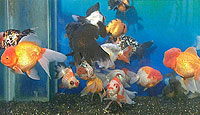Fancy Goldfish
Goldfish are very popular as pets because they are attractive, cheap to buy and fairly easy to look after. You can find goldfish in most pet shops for around $2.50 each. Rare varieties of goldfish, known as fancy goldfish, are much more expensive and are highly sought after by collectors. Indeed the price of some of these fancy goldfish can be $100-$5,000 for one good specimen! Some recent new forms command even higher prices with a new Black and White Moor carrying a $15,000 price tag. Don visited Liverpool Aquariums in Sydney, and looked at some of the most magnificent fancy varieties of goldfish ever seen in Australia.
Breed: Fancy Goldfish
Temperament: quiet and unobtrusive
Cost: $7.50 (small) – $20 (large) but up to $5000 – $15,000 for rare or new varieties
Lifespan: 8 years or less in aquariums, up to 25 years in ponds
Maintenance: medium
Recommended for: children and hobbyists
History
Goldfish (Carassius auratus) originated in eastern Asia about 1600 years ago. They are the result of selective breeding of green/brown carp found in the streams of southern China. They were developed first by the Chinese, then later the Japanese, with each country producing slightly different features in the fish. The Chinese exaggerated the more unusual and attractive characteristics, such as protruding eyes and double tails.
Breeding
Goldfish are genetically very pliable, which explains the amazingly wide range of colours, as well as body, head, eye and fin shapes. By selecting goldfish exhibiting desirable traits, breeders produce offspring which show these traits and then use the offspring to develop stable strains of fish. The exotic varieties produced are very different from the wild type. Common goldfish are hardier and more resilient than fancy goldfish varieties.
Goldfish typically come into breeding condition at around 8 to 12 months of age. At this time, male goldfish develop ‘breeding tubercules’ (protuberances on the leading ray of the pectoral fins and on the large scale covering the gill). Females come into spawning condition in springtime when water temperatures rise to around 20C. Males can be so persistent in their pursuit of the females that sometimes the females die from exhaustion.
Colour
Young domesticated goldfish are usually an olive colour, and they change to adult coloration when they are about 1 year old or more. A fish’s ultimate colour is strongly influenced by genes, its diet and the chemical composition of the water in which it is reared. Black is the most difficult colour to breed and pure jet-black goldfish are rare. They are considered highly desirable by hobbyists. It has been claimed that the gene for telescope (protruding) eyes is linked to the gene for all-over black colouring.
Features
Breeders favour fancy goldfish with unusual features, including: telescope eyes – protruding eyes celestial eyes – upward facing eyes pom pons – nasal appendages or swollen lumps warty growths on the head – these lumps or crests are a feature of Lionheads
Varieties
It is estimated that there are more than 125 varieties of fancy goldfish. They include:
Orandas, a popular variety with a shortened body, a prominent dorsal fin, a twin tail, a large warty growth or crest on the head and elegant, flowing fins. They come in red, chocolate, black, red-cap, red and white, red and black, blue and calico (a mixture of metallic and non-metallic colours).
Lionheads, like Orandas, have a twin tail and a big, warty crest on their heads. However, they do not have a dorsal fin. They are mostly red, but black, red-cap, calico, and red and white varieties are also available.
Ranchus have very high, arched tail fins, deep round bodies and short fins.
Veiltails have deep, round bodies and a long, broad, gracefully folded tail divided into two. Their anal fin is also divided into two.
Moors are small goldfish with smooth, soot-like colouring. Although referred to as the Black Moor, they also occur in light red or light orange colours. They have telescope eyes, a double tail and fins identical to the Veiltails.
The Ryukin is a short, narrow Japanese variety with a hump where its head meets its body. It has a forked tail which is divided into two fins. There is a version of Ryukin known as the Fantail, which is seen in both the telescope-eyed and normal configurations.
The Pearlscale is usually silver coloured with large red patches. It has a flat back, fat body and a small-mouthed head. Each scale is swollen and sticks out like a tiny half pearl.
Pom Pons have swollen nasal appendages that look like frilly balls or pom pons on a hat. There are two types of Pom pon, one with a dorsal fin, one without. It occurs in most colours. On rare occasions goldfish with four pom pons are produced. These fish are considered very desirable, as long as the pom pons grow evenly in size.
Getting started
The bigger the tank the better. Resist the urge to keep your goldfish in a small bowl, as the surface area of bowls is usually inadequate, so the fish can’t get enough oxygen. Beginners need only acquire a basic setup consisting of a 60cm (2′) tank complete with pumps for about $150. Change 30% of the water once a week and remember to treat new water with appropriate chemicals (test pH and use softeners to neutralise the chlorine in tap water). Breeders recommend feeding goldfish a variety of dry and live food including goldfish flakes, pellets and blood worms.
Contact information
Our segment was filmed at:
Liverpool Aquariums
288 Macquarie Street
Liverpool, NSW 2170
Phone: (02) 9824 2833



